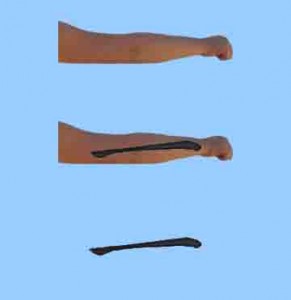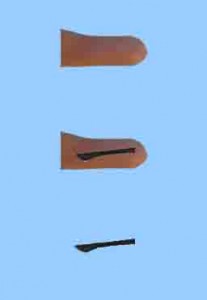The second of the 6 primary strokes is the horizontal stroke, called 横 (héng) in Chinese.
To form the horizontal stroke, 1 joint of the arm must shift position. To represent the horizontal stroke, from the initial position of the arm alongside the body, rotate the shoulder joint upward and outward 90o toward the right, such that the arm is horizontal. The upper arm, the lower arm, and the hand extend along a single straight line. The wrist holds the same position as before, in line with the forearm, but the fingers make a change; the fingers of the hand close into a fist that faces downward.
In the drawing of this stroke, Rule 2 applies: Strokes are drawn from left to right. Rule 1 does not apply, since there is no vertical in this stroke. Since this stroke honors both rules, and does not violate either, it is represented using the right arm and hand.
If the horizontal stroke crosses the vertical stroke, it often defines the center point of the character or character part. If the horizontal stroke only touches the vertical stroke, but does not cross it, then it is simply a stroke that touches the midline. This is the only primary stroke that can touch the midline vertical stroke.
There is a shortened variation of this stroke. The elbow can be bent, rotating the forearm forward, such that the forearm is no longer visible.
The following is an example of a character that uses both the long and short forms of the horizontal stroke.
The long form has a variation that adds the hook stroke. This stroke is called 横鉤 (hénggōu), horizontal stroke with a hook. In this stroke, the hook is always required.
The character that means eternal (yǒng) contains the héng stroke; it is the half-width horizontal stroke that touches the midline vertical stroke at the top.



